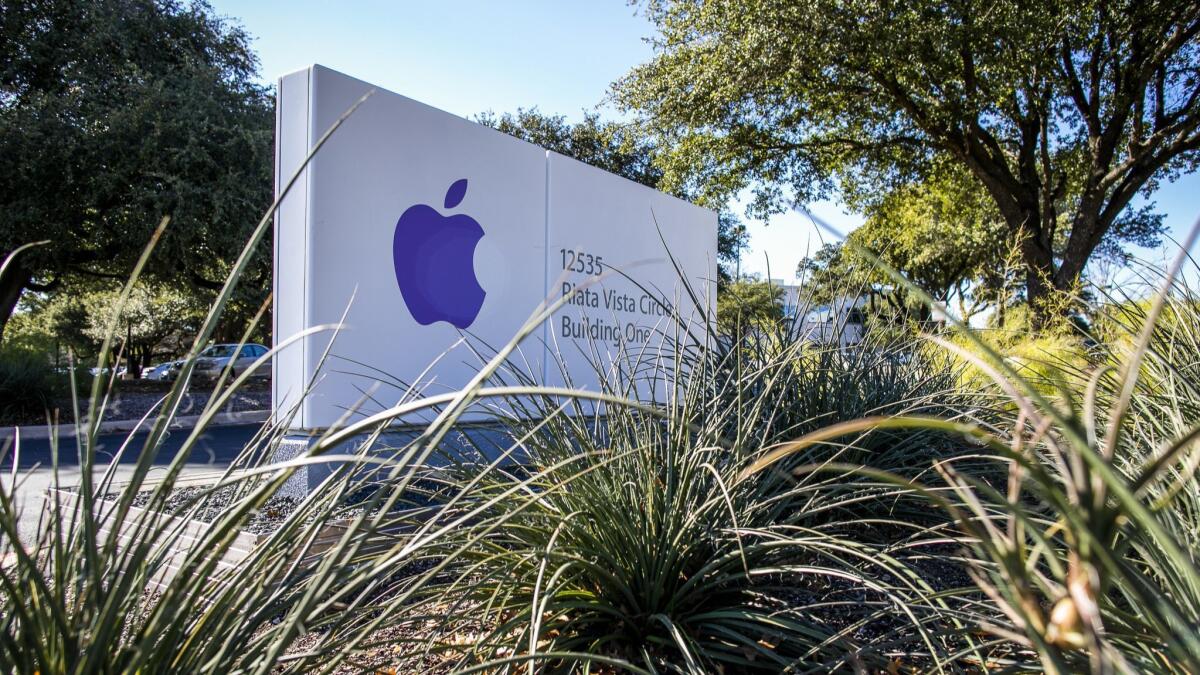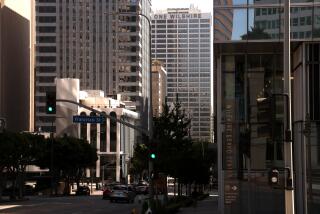Apple is the latest tech giant looking for a home away from home

- Share via
Apple will expand its workforce at new and existing offices across the country and plans to build a billion-dollar campus for 5,000 additional employees in Austin, Texas.
Though Austin will land the biggest part of the Silicon Valley giant’s expansion, the Cupertino company also announced plans Thursday to open additional offices in Culver City, San Diego and Seattle — bringing headcounts to 1,000 in each over the next three years. It will add hundreds of employees in its offices in Boulder, Colo., Pittsburgh and New York as well.
“Talent, creativity and tomorrow’s breakthrough ideas aren’t limited by region or zip code, and, with this new expansion, we’re redoubling our commitment to cultivating the high-tech sector and workforce nationwide,” Apple Chief Executive Tim Cook said in a statement.
Despite Cook’s rhetoric, Apple — which employs 90,000 workers in roles ranging from retail to engineering across the country — isn’t spreading its high-end tech jobs too widely. Like other behemoths in its industry, it’s picking cities that already fit a certain tech-ready mold.
Thursday’s announcement follows on the heels of similar moves from other West Coast tech conglomerates. Google executives have discussed plans to more than double the company’s 7,000-employee operation in New York City. Amazon, after pitting cities against one another in a yearlong bidding war for its new mega-offices, settled on splitting 50,000 workers between New York City and the D.C. metro area, which already boast established tech economies.
The places where Apple is looking to grow share a similar profile, with vibrant cultural scenes and the types of amenities favored by high-income tech workers.
“The digital strong get stronger, in terms of tech employment,” said Mark Muro, senior fellow and policy director at the Brookings Institution’s Metropolitan Policy Program. “Big tech companies are looking for the same demographic, the same sorts of development talent, and those are pooling and agglomerating in a short list of big places — Austin is very much cut from the same cloth.”
Nearly 45% of tech industry jobs are concentrated in 10 major metropolitan areas, according to research set to be published by Muro’s office this month.
But the success of technology companies in their historic home — the San Francisco Bay Area — has in a way become a burden. With 10% of the nation’s total tech workforce competing for housing in the region, prices have soared and traffic has intensified, making other areas more attractive to some workers.
“You have only to look at Seattle and the Bay Area as the state-of-the-art dystopian over-concentrations,” Muro said. “These industries have brought tremendous prosperity, but they’ve also created a quality-of-life disaster in many respects.”
In January, Apple laid out plans to add 20,000 jobs and invest more than $30 billion in the United States over the next five years in response to the huge tax windfall it would receive under the tax cuts signed into law in late 2017.
The company, which is the most profitable in the world, had long been criticized for hoarding money overseas to avoid taxes, but a provision in the 2017 cuts allowed for a one-time repatriation of cash held abroad at a lower rate. Previously, those earnings would have been taxed at the standard 35% corporate tax rate. Under the new law, the rate is just 15%.
Apple took advantage of the discount to bring back much of its overseas holdings, the company said in January, adding that it would make a one-time tax payment of $38 billion as a result.
Culver City’s mayor told The Times that Apple is not receiving any financial incentives in the city. In Austin, Apple is set to receive as much as $25 million in taxpayer-funded grants and is seeking a 15-year property tax abatement from Williamson County, according to reporting by the Austin American-Statesman.
Apple’s plans to expand its footprint with a new Culver City office are a sign of its growing investment in original content production.
The company is expected to spend $1 billion this year on original content, increasing to $4.2 billion in 2022, according to venture capital firm Loup Ventures.
The company is putting money in TV shows and films at a time when investors are concerned that its main business — selling iPhones — is slowing. Apple has focused on building up other businesses, including subscription services such as Apple Music. The tech giant plans to launch a streaming television service next year, according to digital media company the Information.
In January, Apple leased a four-story building near Culver City’s art gallery district to house its pending expansion. Apple declined to comment on how many people it employs in Culver City.
The company established a significant footprint in the city when it acquired Beats Electronics in 2014 for $3 billion in an effort to enter into the streaming music space. At the time, Beats had roughly 700 employees in Culver City, and Apple was expected to lay off roughly 200 workers in 2014. Since then, Apple has been hiring to build up its efforts in video. One recent hire is Tamara Hunter, Apple’s head of casting for worldwide video, previously head of feature casting for Sony Pictures Entertainment.
The largest planned expansion is set for North Austin, where the company will build a campus covering more than 130 acres less than a mile from its current office complex, according to the announcement.
Though initial plans call for 5,000 new positions, the facility will have capacity for the company to hire up to 15,000 workers in the area, which would make Apple the largest private employer in the Texas capital.
“Apple is among the world’s most innovative companies and an avid creator of jobs in Texas and across the country,” Texas Gov. Greg Abbott said in a statement. “Their decision to expand operations in our state is a testament to the high-quality workforce and unmatched economic environment that Texas offers.
Apple’s Cupertino headquarters, nicknamed “the spaceship” for its UFO-like design, has capacity for 13,000 employees, though the company employs an estimated 26,000 total across the city.
Twitter: @samaugustdean
Twitter: @thewendylee








